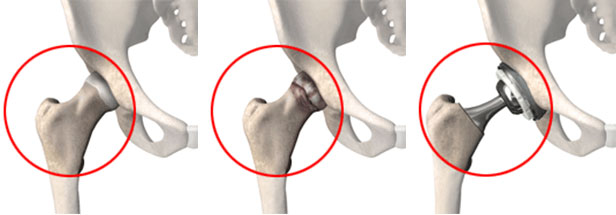Computer-assisted Hip Replacement
In order to understand what a total hip replacement is, you must first understand the structure of the hip joint. The hip joint is a ball and socket structure. The ball component is attached to the top of the femur (the long bone of the thigh). The socket is part of the pelvis. The ball rotates in the socket to permit you to move your leg forward, backward, away from the body, across your body, and in partial rotation. Total hip replacement is an operation which consists of replacing the diseased ball and socket with an artificial device.

- In the healthy hip, smooth slippery cartilage covers the ends of the thigh bone and the pelvis. This allows the ball to glide easily in any direction inside the socket.
- In a hip requiring total hip replacement surgery, the worn cartilage no longer serves as a cushion. As the damaged bones rub together, they become rough, with a surface like sandpaper. This results in pain with almost any movement, and decreased mobility.
- In a total hip replacement, the ball replaces the end of the thigh bone, the stem component of the ball which is made of super alloy material, is inserted into the thigh bone for stability. A cup that replaces the worn hip socket is made of titanium and durable plastic material. The prosthesis is held in place either by new bone growing around it or by a cement-like material.
This operation has proven to be highly successful in millions of patients worldwide. At Hospital for Special Surgery, we have performed over 80,000 total hip replacements from 1967 to the present.
Pre-admission testing is usually performed within 30 days of surgery. The same day, patients will be seen by one of our internists to be medically cleared. An educational class and book will be given reviewing all the aspects of admission, hospitalization and recovery. A social worker will discuss the discharge plan to your home or to a rehabilitation center.
Patients are admitted on the day of surgery. The operation takes from one to one and a half hours depending on the complexity of the deformity of your hip. Most patients prefer to sleep during the operation. An epidural anesthesia is used for surgery as well as anesthetic medication given into your incision to minimize pain. With this method the postoperative pain is minimal. The day after surgery, analgesics are given by mouth, intravenously or intramuscularly.
During surgery, a computer device is used to make sure the cup and stem are well positioned. Properly positioned components are necessary for your hip replacement to function well, minimize wear, improve range of motion and diminish the chances of dislocation (the ball coming out of the socket).
After the operation, patients remain in the Recovery Room where they are closely monitored and supervised. They are moved to their rooms after several hours or the next morning after being cleared by the medical doctor or anesthesiologist. Patients usually sit and stand on the same of the next day after surgery, and walk with the aid of a walker, progressing to a cane in the next few days.
Patients are discharged home when they can ambulate well with the use of a cane and can do stairs independently, holding the banister, around the second day after surgery. At the time of discharge, written instructions are given, outlining the Do’s and Don’ts and exercises.
Patients who live alone, who progress slowly, or with other limitations, can be discharged to a rehabilitation center, if your insurance covers it. Please discuss the discharge plan with my staff and the hospital’s social worker.
Thereafter, patients are seen by me about five to six weeks after surgery for a clinical and radiographic examination, and according to their progress, new exercises and written instructions are given. Patients should be able to walk without the use of a walking aid in about four to six weeks, and the maximum benefit is usually achieved a few months after surgery.
In our experience, total hip replacement has been highly successful in relieving pain, improving ambulation and hip motion, equalizing the length of your legs, and reducing disability. Though the range of motion of your hip is generally improved, there are some movements that you will not be allowed to do in order to prevent complications. None of the results previously mentioned, however, can be guaranteed, as there is a certain risk of complications. The complications are rare, and include infection, dislocation, nerve/vascular damage, clot formation, and other medical problems. In each case, patients are carefully analyzed and treated accordingly so as to avoid complications, trying to achieve the best possible result.
This is a brief description and should serve as a general guideline only since each patient is different and the potential for recuperation and complications varies widely according to age, general health, type of hip problem, previous operations, etc.
Copies of the instructions given at the time of discharge, at six weeks after surgery, the precautions the patient should follow to protect the artificial hip, and information about orthopedic devices and risks of complications are available upon request.
Thank you for reading this information carefully. I encourage you to discuss any questions that you may have regarding the operation or any other medical aspects with me. Other questions regarding insurance coverage, dates, scheduling, etc. should be directed to my staff.
For additional information, instructions and educational videos please visit VIDEO LIBRARY




